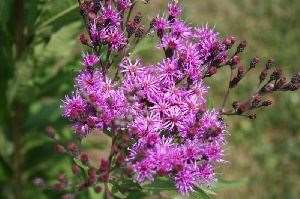Field Guide  Weed Management
Weed Management  Tall Ironweed
Tall Ironweed
Tall Ironweed (Vernonia altissima)
Crop Impacts: Pastures
 | |
About Tall Ironweed:Tall Ironweed is a perennial plant that is native to North America. There is about 17 species of ironweed that is recognized throughout North America, with the majority of them found in Puerto Rico and the southeast. The bright colors and nature of this weed do an excellent job at providing an environment for butterflies and bees. However, it is very competitive in gardens and becomes widely spread once it is cultivated. Family: Asteraceae ⁄ Compositae – Aster family  
Tall Ironweed Scouting and Prevention:Tall Ironweed can grow between 1 and 3 meters tall with smooth stems and some silky white hairs near the bottom of the leaf base. It has leaves that alternate along the stem and sit at about 10 to 30cm long and 2 to 4cm wide. They are typically dark green and smooth on top and light green-whitish on the bottom. Tall Ironweed produces stemens (male parts) and pistil (female parts) with each flower. The plants produce these pink disk flowers that are shaped like flare tubes that flower from July to September. On each tube there are 5 petals that are separated at the top and have been fused at the bottom. The heads of the flowers are typically in clusters of 10 to 20 at the end of their branches. Normally each head has about 15 to 25 individual disk flowers coming out of it. Common locations- - Sandy soil
- - Clay soil
- - Loam soil
- - Wet to moist soil
Tall Ironweed Control:Cultural ControlMowing is a great way to reduce seed production. This, combined with herbicides applied to the regrowth can be an extremely effective control. Repetitive mowing when the regrowth of Tall Ironweed reaches 6 to 8 inches is important to significantly reduce the original population. There is a chance that mowing periodically will increase the number of multi-stemmed tall ironweed. Chemical ControlFor chemical control it is important to note that the best time to spray herbicides is when the plant is less than 12 to 15 inches tall and has yet to be mowed. Glyphosate has been shown to have effective control on tall ironweed. It is; however, dependent on the weather. Glyphosate is most effective when it is applied to weeds that are growing in good conditions. Another important note about glyphosate is that it can only be applied as direct application or pot application due to the fact that it can injure desired plants. Herbicides with the active ingredient triclopyr (Garlon 3A, Gatlon 4 & Ultra) plus 2,4-D provides 91% or more control over Tall Ironweed. The preferred time to apply these herbicides is from late May to August. Latin / Alternative Tall Ironweed names:- - Vernonia altissima
- - Giant ironweed
- - Ironweed
Additional Tall Ironweed Resources |
http://www.fs.fed.us/wildflowers/plant-of-the-week/vernonia_gigantea.shtml
http://www.thehorse.com/articles/26008/weed-of-the-month-tall-ironweed
http://www.ppdl.purdue.edu/PPDL/weeklypics/9-22-08.html
http://www2.ca.uky.edu/grazer/july12_tall_ironweed.php